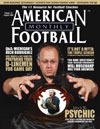AMERICAN FOOTBALL MONTHLY THE #1 RESOURCE FOR FOOTBALL COACHES
Article CategoriesAFM Magazine
|
The Winning Edge: Preparing D-Linemen for Game Dayby: Mike KucharSenior Writer, American Football Monthly © More from this issue Mike Waufle and Ray Hamilton know defensive line play. Between the two of them, they have a total of 49 years of coaching experience at the Division I level and professional levels of football. Among those in their tutelage are the likes of Andre Tippett, Russell Maryland and Michael Strahan. So it’s only fitting that the two guru’s of defensive line play collaborated on producing a scouting form called the “Winning Edge” which they give to each of their players during game week. Actually, Hamilton concocted the idea when he was with the Patriots in the mid 1990’s, when Waufle would make routine trips east from UCLA to talk football. Although the entire “Winning Edge” form is available through AFM, both coaches- Waufle the defensive line coach with the Super Bowl Champion New York Giants and Ray Hamilton with the Atlanta Falcons- talk....The full article can only be seen by subscribers. Subscribe today!
|
|
|||||||
| HOME |
MAGAZINE |
SUBSCRIBE | ONLINE COLUMNISTS | COACHING VIDEOS |
Copyright 2025, AmericanFootballMonthly.com
All Rights Reserved





